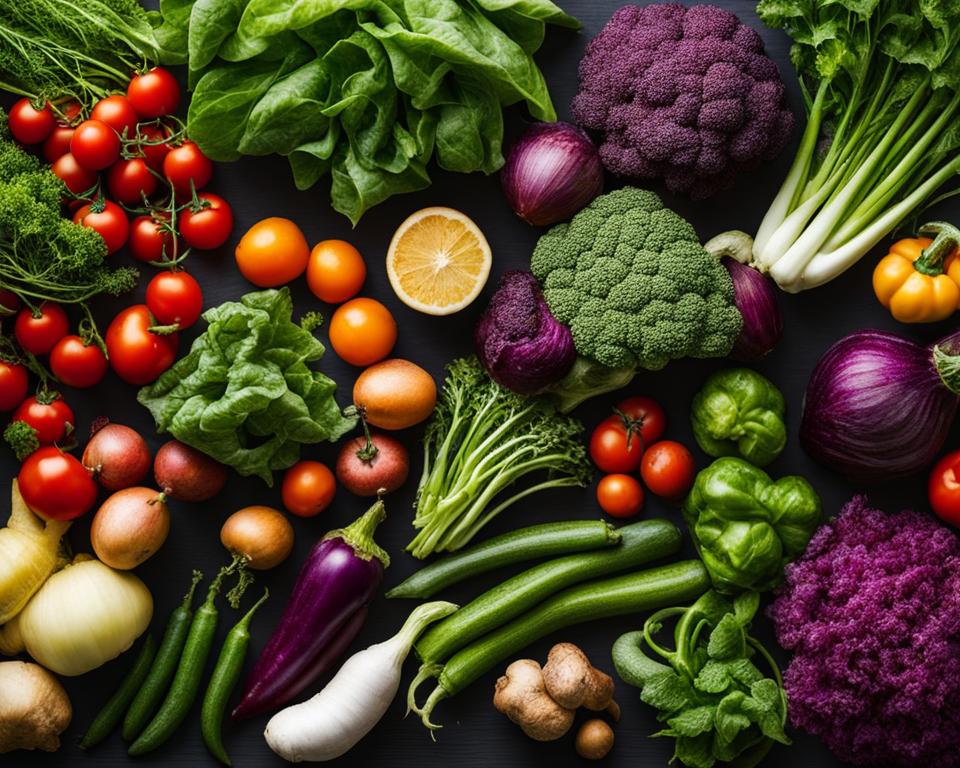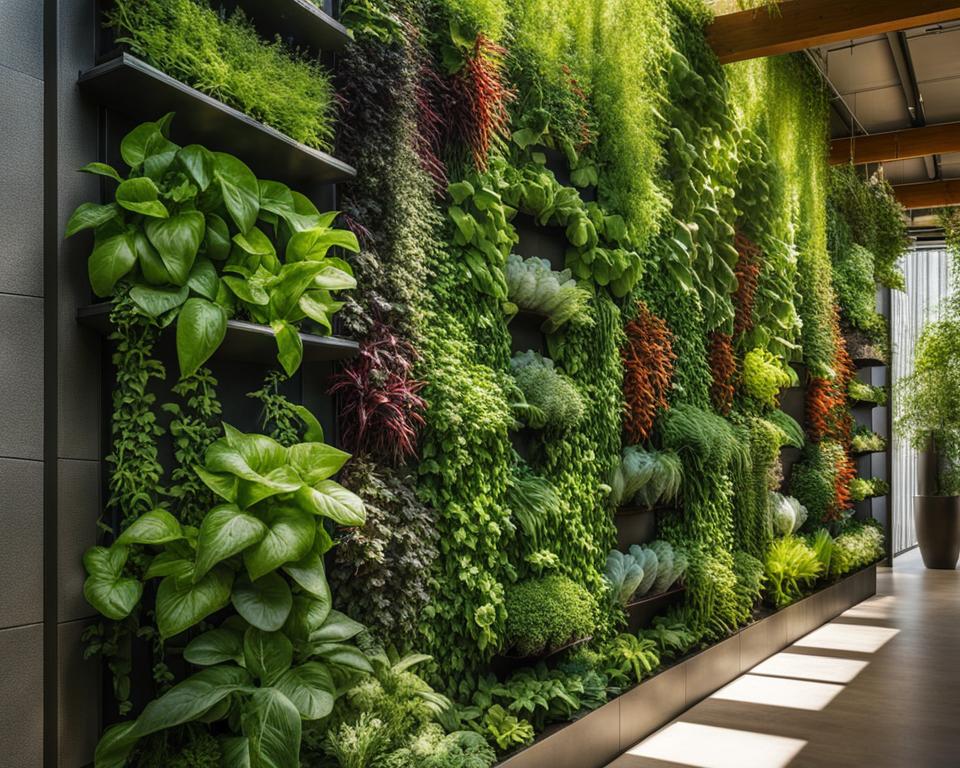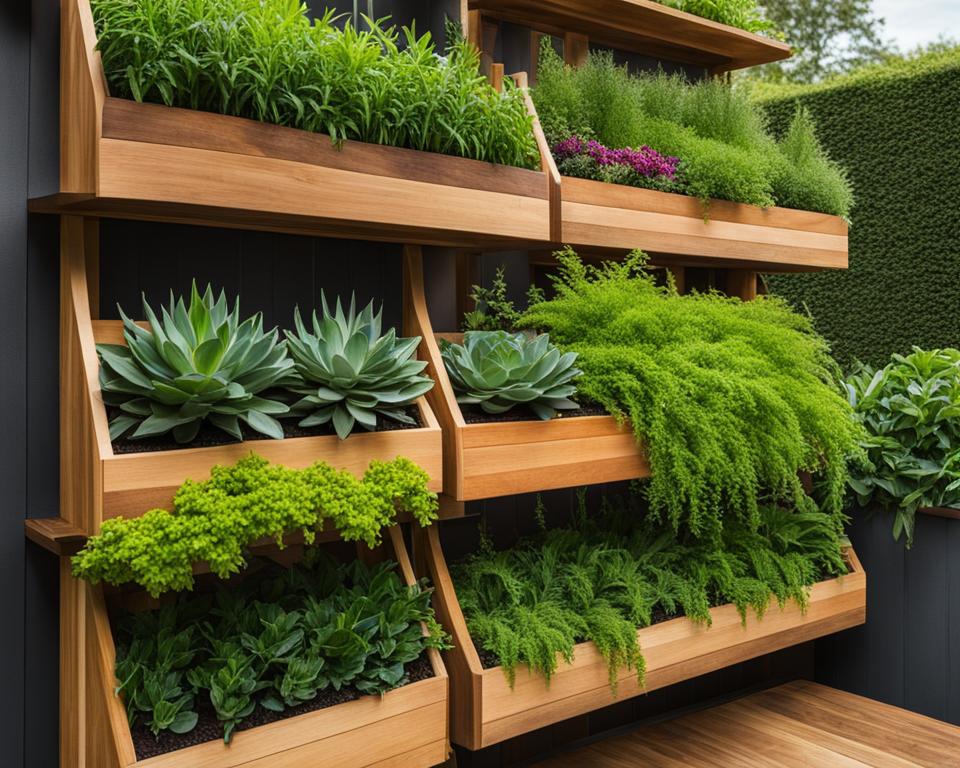Do you dream of having a lush, productive garden, but feel limited by the lack of horizontal space in your urban environment? Don’t let that stop you from growing your own vegetables and creating a beautiful green oasis. Vertical vegetable gardening systems can be the perfect solution, maximizing your available space and transforming even the smallest of urban balconies into bountiful gardens. Urban vertical gardening is a trend that’s here to stay, and with some practical guidance, you too can enjoy the many benefits of growing up – literally!
Key Takeaways
- Vertical vegetable gardening systems can help you make the most of limited space in urban environments.
- Urban vertical gardening is a space-efficient approach to cultivating vegetables and creating lush green spaces.
- Vertical gardening techniques are revolutionizing the way we grow our own food in cities.
- Discover how to choose the right vegetables for your vertical garden and maximize your yield.
- Get inspired by innovative designs and DIY vertical garden projects to create your own stunning and productive space.
Embracing the Vertical Revolution in Urban Gardening
As urbanization increases and available space for traditional gardens dwindles, the vertical revolution is reshaping the way we approach urban gardening. The innovative techniques associated with vertical gardening have transformed small space vegetable gardening, allowing city dwellers to cultivate fresh, green produce in their homes despite limited horizontal areas.
Vertical gardening solutions have numerous advantages beyond space-saving. They can also improve plant health, increase yields, and create visually appealing gardens in otherwise unused spaces. This section delves into the revolutionary world of vertical gardening, exploring its benefits and urging you to make the switch from traditional gardening practices to more space-efficient techniques.
- Modern vertical garden structures
- Types of vegetables suitable for vertical cultivation
- Innovative and creative vertical gardening ideas
By understanding the principles of vertical gardening, you can transform a cramped urban space into a lush, productive green oasis.
| Traditional Gardening | Vertical Gardening |
|---|---|
| Requires a large amount of horizontal ground space | Maximizes limited vertical space available |
| Lower yields per square foot | Higher yields per square foot |
| Pests can easily access plants | Reduces pest access and damage |
| Less visually dynamic | Offers more room for creative designs |
| Plants compete for sunlight, water, and nutrients | Improved access to sunlight, water, and nutrients |
Implementing small space vegetable gardening techniques allows you to harness the benefits of vertical gardening in an urban environment. From practical advantages, like higher yields and reduced pest problems, to aesthetic improvements, such as more dynamic and visually striking garden designs, there are many reasons to join the vertical revolution.
“The vertical revolution is not just a fad; it’s a sustainable solution for urban gardeners looking to cultivate fresh, organic produce in small spaces.”
As you embark on your vertical gardening journey, keep an open mind, and be prepared to embrace innovative techniques that have revolutionized urban gardening. The sky is the limit when you start growing upwards!
Understanding the Basics of Vertical Vegetable Gardening Systems

As urban spaces become more limited, it’s essential to have a firm grasp of vertical gardening basics, which can help turn your small garden into a lush, productive oasis. In this section, we will define vertical vegetable gardening, explore various structures used in this approach, and discuss the numerous benefits of adopting this innovative gardening method.
Defining Vertical Vegetable Gardening
Vertical vegetable gardening is a modern approach to gardening that involves growing vegetables upwards rather than outwards, utilizing structures such as trellises, towers, and wall planters. This method significantly differs from traditional gardening, as it focuses on maximizing vertical space to achieve higher yields in a limited area. Vertical gardening is particularly useful in confined urban environments, where cultivating vegetables using traditional methods can be challenging due to space constraints.
Benefits of Going Vertical
Adopting a vertical gardening approach comes with a range of practical advantages:
- Efficient space use: Vertical gardening allows you to make the most of limited space, making it an ideal solution for those with small gardens or balconies.
- Potentially higher yields: By utilizing vertical space, you can grow more vegetables in a small area compared to traditional methods.
- Ease of maintenance: With plants growing vertically, it’s easier to reach them for watering, pruning, and harvesting.
- Pest reduction: Raising plants off the ground can help minimize the risk of pest infestation, as many common garden pests have difficulty climbing vertical surfaces.
- Aesthetic value: Vertical gardens can serve a dual purpose by providing both beauty and functionality, making your garden visually appealing and productive.
Understanding the vertical gardening basics sets the foundation for successful vertical garden planning, ultimately transforming your small space into a thriving vegetable garden. Next, we’ll focus on choosing the right vegetables for your vertical garden, maximizing both yield and beauty.
Choosing the Right Vegetables for Your Vertical Garden

When designing a vertical garden, selecting suitable vegetables is crucial to ensure a thriving and productive green space. By considering factors like plant size, weight, root depth, and growth habits, you can make informed decisions about which vegetables will perform best in your vertical garden containers. In this section, we’ll explore some ideal vegetables for vertical gardening and offer tips for a bountiful harvest.
Before diving into the specific vegetables, it’s essential to understand the attributes that make them suitable for vertical gardening. Ideal vegetables for vertical gardens typically share the following characteristics:
- Compact size and growth habits
- Light to moderate weight
- Shallow to medium root systems
- Adaptable to various support structures
With these characteristics in mind, let’s explore some suitable vegetables for vertical gardening.
“Success starts with choosing the right plants for your vertical gardening containers.”
| Vegetable | Type | Growth Habit | Support Structure |
|---|---|---|---|
| Pole Beans | Vining | Climbing | Trellis, Poles, Netting |
| Cucumbers | Vining | Climbing | Trellis, Cage, A-Frame |
| Tomatoes | Indeterminate | Climbing | Cage, Stakes, Spirals |
| Peas | Vining | Climbing | Trellis, Netting, Poles |
| Peppers | Bushy | Upright | Small Trellis, Stakes |
| Lettuce | Loose-Leaf | Bushy | Wall Planter, Vertical Planter |
| Spinach | Loose-Leaf | Bushy | Wall Planter, Vertical Planter |
| Strawberries | Compact | Spreading | Wall Planter, Vertical Planter, Tower |
You might notice a trend among many successful vegetables for vertical gardening: vining or climbing varieties. Embracing plants like pole beans, cucumbers, tomatoes, and peas that naturally grow upward will considerably boost your gardening space’s efficiency. However, don’t forget about bushy and compact vegetables like peppers, lettuce, spinach, and strawberries that can grow in vertical containers without the need for elaborate support structures.
In conclusion, the key to a thriving vertical garden is selecting the right vegetables that can adapt to a vertical environment. Whether you opt for vining plants, bushy vegetables, or low-growing, compact plants, your vertical garden will be lush, abundant, and rewarding. Happy gardening!
Innovative Vertical Gardening Ideas to Maximize Your Yield
Enhancing the productivity of your vertical garden becomes a reality when you implement innovative vertical gardening ideas. By utilizing vertical planters and incorporating climbing varieties of vegetables, you can maximize yield vertical gardening and transform your small space into a thriving, lush green area.
Using Vertical Planters
There is a wide range of vertical planters available on the market that cater to different needs and design preferences. Let’s explore some popular options:
- Stacked pots: These planters consist of multiple pots stacked on top of each other, creating a cascading effect. They are great for saving space, and the pots can be rotated for more even light exposure.
- Fabric pockets: Made of breathable fabric, these pocket planters can be attached to wall surfaces or fence panels, providing excellent drainage and air circulation to the roots.
- Vertical garden towers: These freestanding structures are perfect for urban balconies or patios with limited space. They often come with built-in watering systems for easy maintenance.
When choosing a vertical planter, consider factors such as the size of your space, the type of vegetables you want to grow, and your personal aesthetic preferences. The right planter can elevate your vertical garden design and boost your yield.
Incorporating Climbing Varieties
Climbing vegetables, also known as vining plants, are a natural fit for vertical gardening. They not only save space but also create eye-catching displays. Some climbing vegetables that thrive in vertical gardens include:
- Green beans
- Peas
- Tomatoes
- Cucumbers
- Winter squash
To support these plants, you can use various structures like trellises, cages, and arbors. These support structures not only promote healthy growth but also add visual interest to your garden.
“The right combination of vertical planters and climbing plants can drastically increase the yield of your vertical vegetable garden while enhancing its overall appearance.”
Remember to research the specific requirements of your chosen climbing varieties, as some may need more sunlight, support, or care than others. As you maximize yield vertical gardening through innovation, you will experience the full potential of your small space.
Designing Your Vertical Garden for Beauty and Productivity

Designing a productive vertical garden that is also visually appealing requires careful planning and consideration. By incorporating design principles, strategic arrangement of plants, and color coordination, you can create a stunning and functional vertical garden. In this section, we will explore some useful tips and techniques to help you achieve an eye-catching display while maximizing your planting space for a fruitful harvest.
First, let’s discuss the importance of layout and design in vertical gardening. A well-planned layout ensures your plants receive adequate sunlight, airflow, and support while also contributing to the overall aesthetic of your garden. Consider the size, growth habits, and sunlight requirements of your chosen vegetables to create an efficient, visually appealing design. For example, taller plants should be placed towards the back or on top of the vertical structure to avoid shading smaller plants.
Next, color coordination plays a vital role in creating a beautiful and harmonious vertical garden. Color can be used both to provide visual interest and to guide the eye through the space. Consider incorporating complementary or analogous colors to create a pleasing and eye-catching effect. Remember, though, that it’s not just the colors of the flowers that matter; the foliage of your plants can also contribute to the visual appeal of your garden.
“In vertical garden designs, color coordination creates unity and balance while enhancing the overall appearance of your garden.”
Another essential aspect of designing a productive vertical garden is the arrangement of plants. Be mindful of the spacing between plants to ensure they have enough room to grow and develop without competing for resources. Additionally, place plants with similar light and water requirements together to make maintenance easier and more efficient.
- Choose the right vertical structures: Select appropriate vertical garden designs that support the weight, size, and growth habits of your chosen plants.
- Group plants with similar needs: Maximize efficiency by placing plants with similar light, water, and nutrient requirements together.
- Incorporate climbing plants: Make use of climbing plants, such as beans or peas, which are well-suited for vertical growth and require minimal support structures.
- Rotate crops: Regularly rotate your plants to maintain the health and productivity of your vertical garden.
To help you plan your vertical garden, here’s a simple table of vertical garden designs that showcase suitable support systems and potential plant pairings:
| Vertical Garden Designs | Support System | Plant Pairings | Trellises | Wooden or metal frames with lattice or mesh | Cucumber, peas, tomatoes, pole beans |
|---|---|---|
| Green Walls | Wall-mounted planters or pockets | Lettuce, spinach, kale, chard |
| Vertical Planter Boxes | Stacked or tiered boxes with individual plant slots | Strawberries, herbs, small vegetables |
| Container Tower | Vertical pots or containers | Herbs, dwarf or compact vegetable varieties |
By taking design principles, plant arrangement, and color coordination into account, you can create vertical garden designs that are both beautiful and productive. Consider the tips and techniques outlined in this section as you design your vertical garden, and enjoy the stunning visual and bountiful harvest that awaits you.
DIY Vertical Garden Projects to Get You Started

Creating your own DIY vertical garden can be both rewarding and cost-effective. With a little creativity and some basic materials, you can transform a small space into a lush, productive garden. In this section, we will guide you through some DIY vertical garden projects and tips to help you choose the right materials for your project.
Selecting Materials for Your DIY Vertical Garden
When selecting materials for your vertical garden, consider factors such as durability, safety, and environmental impact. There are several eco-friendly and cost-effective materials you can use to create a long-lasting vertical garden. Some popular materials include:
- Wood: Reclaimed or repurposed wood is a sustainable option for constructing vertical garden structures like frames, planters, or trellises.
- PVC pipes: Lightweight and durable, PVC pipes can be used to create hydroponic systems or planters for your vertical garden.
- Metal: Galvanized steel or aluminum are solid, rust-resistant options for creating brackets or supports for your vertical garden.
- Recycled plastic: Repurposed plastic containers, bottles, or buckets are great for fashioning unique and affordable planters.
- Fabric: Porous materials like felt or canvas planter bags can be used as grow bags for your vertical garden, ensuring proper drainage and aeration for plants.
Now that you’re familiar with suitable materials for your vertical garden, let’s dive into some DIY project ideas.
“The love of gardening is a seed once sown that never dies.” – Gertrude Jekyll
Here are three DIY vertical garden projects to inspire you:
| Project | Description | Materials Needed |
|---|---|---|
| Pallet Planter | Transform a wooden pallet into a vertical garden by adding a weed barrier fabric and potting soil. Secure your desired plants into the slots. | Wooden pallet, weed barrier fabric, potting soil, plants, staple gun, gardening gloves |
| PVC Pipe Garden | Create a vertical garden system using PVC pipes by drilling holes for plants and attaching the pipes to a sturdy frame or wall. | PVC pipes, drill, plants, wall brackets or frame, screws and anchors, gardening gloves |
| Hanging Fabric Grow Bags | Suspend fabric grow bags from a horizontal rod or beam, creating a vertical column of planters with adequate drainage and aeration. | Fabric grow bags, plants, potting soil, horizontal rod or beam, hooks or brackets, gardening gloves |
With these projects in mind, you’re well on your way to creating a thriving DIY vertical garden. Remember to keep your unique space and growing conditions in mind, and have fun experimenting with different materials and designs. Happy gardening!
Space-Saving Solutions: Vertical Herb Gardens and More
One of the most versatile and practical applications of vertical gardening techniques is in the creation of vertical herb gardens. These space-saving gardens are perfect for small spaces such as balconies, patios, and even indoor environments, bringing fresh, fragrant, and delicious herbs within easy reach for cooking enthusiasts. Let’s explore some popular vertical gardening solutions that can help you make the most of your limited space while enjoying the benefits of homegrown herbs.
A vertical herb garden not only saves space but also adds visual interest and a touch of natural fragrance to your environment.
Some popular vertical gardening solutions for herb cultivation include:
- Hanging herb pouches or planters
- Wall-mounted or freestanding vertical planters
- Repurposed pallets
- Tiered plant stands or ladder planters
Remember: When choosing a vertical solution for your herb garden, ensure that it provides adequate drainage and easy access for watering and harvesting your herbs.
Choosing the Right Herbs for Your Vertical Garden
When selecting herbs to grow vertically, consider their growth habits, environmental needs, and compatibility with neighboring plants. Some herbs, such as basil, require more sunlight than others, like mint, which does well in part shade. Here’s a list of herbs that are particularly well-suited to vertical gardening:
- Chives
- Thyme
- Oregano
- Parsley
- Mint
- Rosemary
- Lemon balm
- Sage
| Herb | Light Requirements | Watering Needs | Growth Habit |
|---|---|---|---|
| Chives | Full sun to part shade | Moderate | Clump-forming |
| Thyme | Full sun | Low to moderate | Creeping or upright |
| Oregano | Full sun | Low to moderate | Creeping or upright |
| Parsley | Full sun to part shade | Moderate | Upright |
| Mint | Part shade to full sun | Moderate to high | Spreading |
| Rosemary | Full sun | Low to moderate | Upright |
| Lemon balm | Part shade to full sun | Moderate | Upright |
| Sage | Full sun | Low to moderate | Upright |
Vertical herb gardens are an excellent example of how space-saving gardening solutions can transform small spaces into lush, productive, and enjoyable areas. With the right vertical gardening setup, a little creativity, and careful selection of herbs, you can enjoy a thriving herb garden that fits right into your urban environment.
How to Care for Your Vertical Vegetable Garden
Vertical gardens are a stunning addition to any urban space, but they also require dedicated care and maintenance to keep them healthy and thriving. In this section, we’ll discuss essential aspects of vertical garden maintenance, such as watering, pest control, and ensuring adequate sunlight and nutrients for your plants.
Watering Your Vertical Garden Efficiently
Proper hydration is crucial to the success of your vertical vegetable garden. However, traditional watering methods may not be effective or efficient enough for vertical gardening. Instead, consider these innovative watering techniques tailored for vertical gardens:
- Drip irrigation: Installing a drip irrigation system allows water to trickle down slowly to the plant roots, ensuring effective absorption while conserving water.
- Self-watering planters: These containers are designed to store water at the bottom and provide a constant supply to the plants as needed, reducing the need for constant watering.
- Misting systems: Ideal for large vertical garden structures, misting systems provide a fine spray of water that evenly covers all plants without causing soil erosion.
Combatting Pests in a Vertical Setting
Managing pests in a vertical garden poses several challenges, but there are effective natural and non-toxic strategies to help you maintain a healthy garden:
- Attract beneficial insects: Encourage the presence of natural predators, such as ladybugs, lacewings, and parasitic wasps, by planting flowers and herbs that attract them.
- Introduce companion planting: Planting certain herbs and vegetables together can deter pests; for example, basil repels mosquitoes and other flies, making it an ideal companion for tomatoes.
- Use insecticidal soaps and oils: Apply these organic, non-toxic solutions to affected areas of your plants to eliminate pests without damaging the environment or harming beneficial insects.
Ensuring Adequate Sunlight and Nutrients
A productive vertical vegetable garden relies on sufficient sunlight and nutrient-rich soil. To achieve this, follow these tips:
- Position strategically: Place your garden in a location where it will receive at least 6–8 hours of direct sunlight daily. Be mindful of shading from structures or neighboring plants, as it could hinder sunlight access for lower sections of your garden.
- Use high-quality soil: Invest in a well-draining, nutrient-rich potting mix designed for container gardening to provide a solid foundation for plant growth.
- Amend soil regularly: Replenish nutrients lost through watering and plant uptake by adding organic matter, such as compost or aged manure, to your vertical garden containers at least once per season.
- Rotate crops: Implement a crop rotation plan to prevent nutrient depletion and reduce the risk of soil-borne diseases. Rotate between heavy feeders, light feeders, and legumes to maintain soil fertility in your vertical garden.
Caring for your vertical garden may require some extra effort compared to traditional ground-based gardens, but the benefits—beauty, productivity, and efficient space utilization—are well worth it. With proper maintenance, your vertical vegetable garden can be a thriving, bountiful oasis in any urban setting.
Conclusion
As we reach the end of our exploration into vertical vegetable gardening systems, it’s clear that urban gardening has found its way to new heights. By optimizing space utilization, incorporating innovative ideas, and focusing on aesthetic appeal, your vertical garden can deliver bountiful yields while beautifying your surroundings.
With the right combination of passion and knowledge, designing your own lush green space becomes an achievable goal. Familiarizing yourself with the basics, selecting suitable vegetables, and implementing creative strategies allow for maximum productivity and enjoyment from your urban gardening endeavors.
In conclusion, the vertical revolution is indeed inspiring and holds the potential to transform urban gardening for the better. We hope that this article has left you feeling both well-informed and eager to embark on your vertical gardening journey. Turn this inspiration into action, and join the community of urban gardeners revolutionizing the way we grow our food in limited spaces.
FAQ
What exactly is vertical vegetable gardening?
Vertical vegetable gardening is a method of growing vegetables in a vertical structure, such as trellises, towers, or wall planters. This technique is ideal for urban gardeners with limited horizontal space, allowing them to create lush, productive green spaces by utilizing vertical surfaces.
What are the benefits of vertical vegetable gardening?
Vertical gardening offers several benefits, including efficient space use, potentially higher yields, ease of maintenance, pest reduction, and aesthetic value. It is particularly well-suited for urban settings where horizontal space is limited, allowing gardeners to transform small areas into lush, green oases.
How do I choose suitable vegetables for a vertical garden?
When selecting vegetables for your vertical garden, consider factors like plant size, weight, root depth, and growth habits. Some vegetables, like climbing varieties, naturally lend themselves to vertical growth and will thrive in these conditions. Examples of suitable vegetables for vertical gardens include tomatoes, cucumbers, peas, and beans.
What innovative vertical gardening ideas can help me maximize yield?
To maximize yield in your vertical garden, consider using vertical planters and incorporating climbing varieties in your design. Vertical planters, such as wall-mounted planter boxes or free-standing plant towers, allow you to make the most of your vertical space. Climbing vegetables require less support and are well-suited for vertical gardening, increasing overall productivity.
What materials should I use for my DIY vertical garden?
Choose durable, safe, and effective materials for your DIY vertical garden, considering factors such as longevity, cost, and environmental impact. Common materials used for vertical garden projects include wood, metal, PVC, and recycled materials like pallets or plastic containers.
How should I care for my vertical vegetable garden?
Care for your vertical garden by providing efficient watering systems, managing pests, and ensuring adequate sunlight and nutrients. Use innovative watering techniques such as drip irrigation or self-watering planters to conserve water. Employ natural and non-toxic options for pest control and ensure your plants receive sufficient sunlight and nutrients through careful positioning and soil amendments.
What are some space-saving solutions for small vegetable gardens?
Vertical herb gardens are a great space-saving solution, particularly well-suited for small spaces like balconies and patios. They allow you to grow a variety of fragrant and useful herbs in a compact vertical structure, making the most of your limited gardening area.

